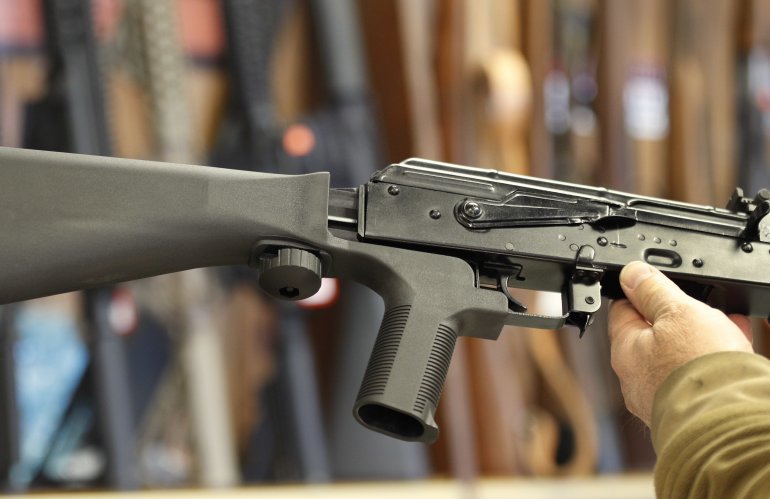Good news for those who still have a bump stock in their closet. The courts have finally put at least the first nail in the coffin on the so-called “Bump Stock” ban implemented after the Las Vegas terror attack.
From Circuit Judge Jennifer Walker Elrod in Cargill v. Garland:
Since the National Firearms Act of 1934, federal law has heavily regulated machineguns. Indeed, as proposed, that law was known to many as “the Anti-Machine Gun Bill.” The possession or transfer of a machinegun was eventually banned through the Gun Control Act of 1968 and the Firearms Owners’ Protection Act of 1986 [with some guns grandfathered in -EV]. Today, possession of a machinegun is a federal crime, carrying a penalty of up to ten years’ incarceration.
This appeal concerns a regulation promulgated by the federal Bureau of Alcohol, Tobacco, Firearms, and Explosives, purporting to interpret the federal prohibition on machineguns as extending to bump stocks. A bump stock is a firearm attachment that allows a shooter to harness the natural recoil of a semi-automatic weapon to quickly re-engage the trigger after firing, enabling him to shoot at an increased rate of speed. When ATF first considered the type of bump stocks at issue here, it understood that they were not machineguns. ATF maintained this position for over a decade, issuing many interpretation letters to that effect to members of the public.
But ATF reversed its longstanding position in 2018, subjecting anyone who possessed a bump stock to criminal liability. ATF reversed its position to a great extent in response to the tragic events that occurred in Las Vegas on October 1, 2017. On that day, a deranged gunman murdered dozens of innocent men and women, and injured hundreds more. To carry out this appalling crime, the gunman used many weapons and utilized many accessories—including bump stocks.
Public pressure to ban bump stocks was tremendous. Multiple bills to that effect were introduced in both houses of Congress. But before they could be considered in earnest, ATF published the regulation at issue here, short-circuiting the legislative process. Appellant Michael Cargill surrendered several bump stocks to the Government following publication of the regulation at issue. He now challenges the legality of that regulation, arguing that a bump stock does not fall within the definition of “machinegun” as set forth in federal law, and thus that ATF lacked the authority to issue a regulation purporting to define the term as such.
Cargill is correct. A plain reading of the statutory language, paired with close consideration of the mechanics of a semi-automatic firearm, reveals that a bump stock is excluded from the technical definition of “machinegun” set forth in the Gun Control Act and National Firearms Act.
But even if that conclusion were incorrect, the rule of lenity would still require us to interpret the statute against imposing criminal liability. A rich legal tradition supports the “well known rule” that “penal laws are to be construed strictly.” United States v. Wiltberger, 18 U.S. (5 Wheat.) 76, 94–95 (1820). As Chief Justice Marshall explained long ago, the rule “is founded on the tenderness of the law for the rights of individuals; and on the plain principle that the power of punishment is vested in the legislative, not in the judicial department. It is the legislature, not the Court, which is to define a crime, and ordain its punishment.” Id. at 95.
The Government’s regulation violates these principles. As an initial matter, it purports to allow ATF—rather than Congress—to set forth the scope of criminal prohibitions. Indeed, the Government would outlaw bump stocks by administrative fiat even though the very same agency routinely interpreted the ban on machineguns as not applying to the type of bump stocks at issue here. Nor can we say that the statutory definition unambiguously supports the Government’s interpretation. As noted above, we conclude that it unambiguously does not. But even if we are wrong, the statute is at least ambiguous in this regard. And if the statute is ambiguous, Congress must cure that ambiguity, not the federal courts.
The definition of “machinegun” as set forth in the National Firearms Act and Gun Control Act does not apply to bump stocks. And if there were any doubt as to this conclusion, we conclude that the statutory definition is ambiguous, at the very least. The rule of lenity therefore compels us to construe the statute in Cargill’s favor. Either way, we must REVERSE.
From the AP via TTAG:
A Trump administration ban on bump stocks — devices that enable a shooter to rapidly fire multiple rounds from semi-automatic weapons after an initial trigger pull — was struck down Friday by a federal appeals court in New Orleans.
The ban was instituted after a gunman perched in a high-rise hotel using bump stock-equipped weapons massacred dozens of people in Las Vegas in 2017. Gun rights advocates have challenged it in multiple courts. The 13-3 ruling at the 5th U.S. Circuit Court of appeals is the latest on the issue, which is likely to be decided at the Supreme Court.
The decision doesn’t have an immediate effect on the ban though because the case now moves back to the lower court to decide how to proceed.
The case was somewhat unique because the issue involves not the Second Amendment but the interpretation of federal statutes. Opponents of the ban argued that bump stocks do not fall under the definition of illegal machine guns in federal law. The U.S. Bureau of Alcohol, Tobacco, Firearms and Explosives says they do, a position now being defended by the Biden administration.
